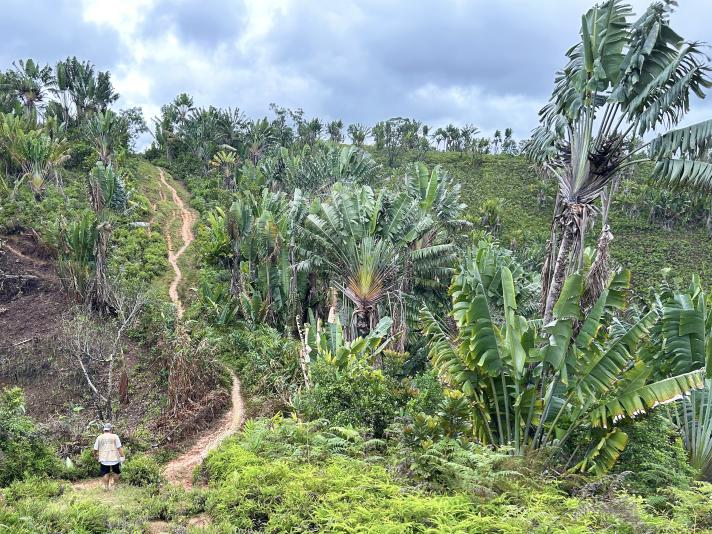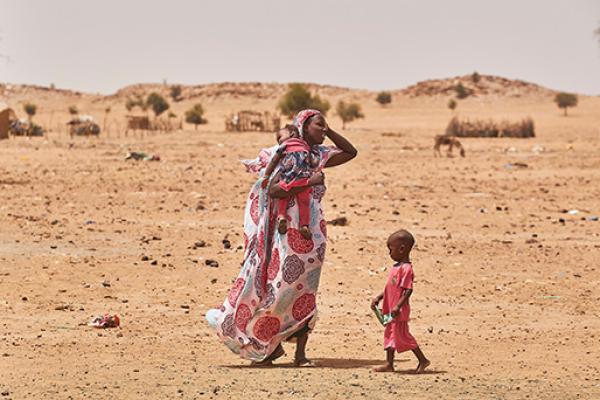
The relentless tropical sun is beating down as we start our walk to one of the many isolated rural villages in southeastern Madagascar. Malnutrition is on the rise in these communities, with hundreds of thousands of people facing acute food shortages.
We soon reach our first obstacle: a murky, slow-moving river running through lush green forest. Children laugh as we clumsily wade across, water to our waists.
“It’s very hard to bring humanitarian aid into these communities,” said Charles Wassouo Bel Bello, a field coordinator with Action Contre Le Faim (ACF), one of the EU’s humanitarian partners here. “People here are largely cut off from all kinds of services.”
We are on our way to Ambodiharamy, an extremely remote hamlet where ACF has dispatched medical teams that provide healthcare and measure malnutrition rates among young children. The food situation in the area has remained critical since 2021, largely due to a string of ferocious cyclones that devasted large areas of the country.
The admission rate for children suffering from severe acute malnutrition has increased exponentially, from 9% in 2021 to 36% in 2023.
The narrow dirt track, still muddy from recent rains, winds its way deeper into the interior and we meet no one for several hours. When we finally arrive in the village, a long line of people has formed outside a tent serving as a temporary clinic.
One of them is Frezina Iarina, 30. She used to own a small plot of land where she grew rice and cassava, but all crops were wiped out by Cyclone Freddy, a powerful and deadly tropical storm that slammed into Madagascar in early 2023.

Picking up the pieces of her former life, Frezina now works as a day laborer, toiling for 10 hours per day in nearby fields. For this, she is given 4 cups of rice. When there is no rice, she is paid 2,000 Madagascan Ariary, or 45 US cents.
“We only eat rice and cassava,” she told me. “The last time I ate meat was at Christmas.”
3 of Frezina’s youngest children show signs of malnutrition and are given fortified peanut paste by the ACF teams.
Madagascar, situated in the Indian Ocean off the coast of southern Africa, has one of the world’s highest poverty rates, exacerbated by recurring natural disasters. Much of the soil is infertile and drinking water scarce.
Government services and road networks are poor, and access by humanitarian agencies to communities in need is extremely difficult. All told, at least 1.3 million people in Madagascar already suffer from malnutrition, according to the UN.
The lack of hygiene across much of the countryside leads to frequent contamination of rivers and other water sources. As a result, diarrhea and malaria are constant and debilitating problems, according to Fabienne Raharinirina, another villager.
“When our children get sick, they refuse to eat and lose all weight,” she says. “The hospital is very far away and we have no money to pay for the treatment.”
Despite the pressing needs, Madagascar has remained a largely forgotten crisis, according to Sylvie Montembault, who oversees EU humanitarian programmes in the country.
“Each year, Madagascar faces recurring droughts, floods and cyclones, which devastate the crops of subsistence farmers, who make up a significant portion of the population,” she says. “The result is widespread hunger, which can lead to severe problems in small children, including stunted growth, impaired cognitive development and lifelong health issues.”
To combat these problems, the EU is supporting humanitarian programmes that address both immediate humanitarian needs and some of the underlying drivers of malnutrition.
“Aside from providing people with food and cash, we are working to improve healthcare services and helping communities prepare for disasters, by setting up early warning systems and coordinating with national authorities,” Montembault says.
To help protect communities from the devastating impact of cyclones and floods, the EU also helps to establish early warning systems and contingency plans, including the pre-positioning of emergency supplies, such as food aid and medical supplies.
In Ampandimana, another isolated village situated by a long canal outside the city of Mananjary, a visiting medical team from the EU’s partner Médecins du Monde (MDM) is screening villagers for malnutrition, malaria and other diseases.
The closest health post is hours away and the only means of reaching a hospital is by navigating the river in a “pirogue” – a long, narrow boat usually made from a carved-out tree trunk.
Villagers tell me that food has been extremely scarce since the last cyclone destroyed all crops and farming equipment. They rely on the frequent visits by aid groups like MDM.
“We often get sick here,” says Marcelline Baomanana, as she is waiting in line to see a healthcare worker. “And when we do, it’s too far to find treatment. Sometimes people die.”
The frequent climate disasters create long-lasting and devastating knock-on effects in small communities like these.
“When all livelihoods are destroyed, people’s overall health rapidly deteriorates,” Montembault says. “To survive, villagers are forced to sell their assets or pull their children out of school. This in turn increases the rates of early marriage and sexual violence. It’s a vicious cycle.”








